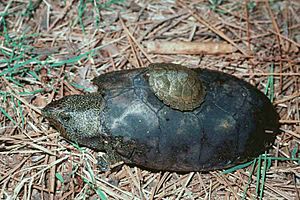Flattened musk turtle facts for kids
Quick facts for kids Flattened musk turtle |
|
|---|---|
 |
|
| adult and hatchling | |
| Conservation status | |
| Scientific classification | |
| Genus: |
Sternotherus
|
| Species: |
depressus
|
| Synonyms | |
|
|
The flattened musk turtle (Sternotherus depressus) is a special kind of turtle. It belongs to a group of turtles called Kinosternidae. This turtle is found only in the southern United States. It's called "flattened" because its top shell, called a carapace, looks flatter than other turtles in its family.
Contents
Where the Flattened Musk Turtle Lives
This unique turtle lives only in a small area. Historically, it was found in the Black Warrior River area in north-central Alabama. Sadly, its numbers have dropped a lot. It has disappeared from over 70% of its original home. This includes parts of the Mulberry Fork and the Locust Fork.
However, populations in the Sipsey Fork are doing much better. This is because the Bankhead National Forest protects their habitat there.
What Does the Flattened Musk Turtle Look Like?
This is a small turtle. Adult flattened musk turtles usually have a top shell (carapace) that is about 7.5 to 10 centimeters (3 to 4 inches) long. The longest one ever recorded was 11.4 centimeters (4.5 inches) long.
Both its common name and its scientific name, depressus, refer to its unique shape. Its upper shell is much lower and flatter than other turtles in the Sternotherus group. It really looks like someone accidentally stepped on it, giving it its "flattened" appearance!
Life in Captivity and Reproduction
Flattened musk turtles have lived for more than 20 years when cared for by humans. While they don't have many babies, they have been successfully bred in captivity sometimes.
These efforts to breed them in captivity are very important. They could help save the species. Once their natural homes are healthy again, these turtles could be released back into the wild.
Why the Flattened Musk Turtle Is in Danger
The biggest problems for the flattened musk turtle are erosion and siltation. These happen because of extensive strip mining for coal and the building of dams. Other issues like cutting down forests, new buildings, and pollution also harm their homes.
Historically, the creeks where these turtles lived had rocky or bedrock bottoms. But due to erosion, these creeks have become muddy and sandy. This means the turtles lose the rocky cracks they use to hide from predators. They also lose the fast-flowing water they need to survive.
See also
 In Spanish: Tortuga de almizcle aplanada para niños
In Spanish: Tortuga de almizcle aplanada para niños


